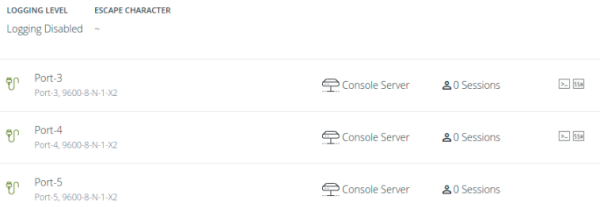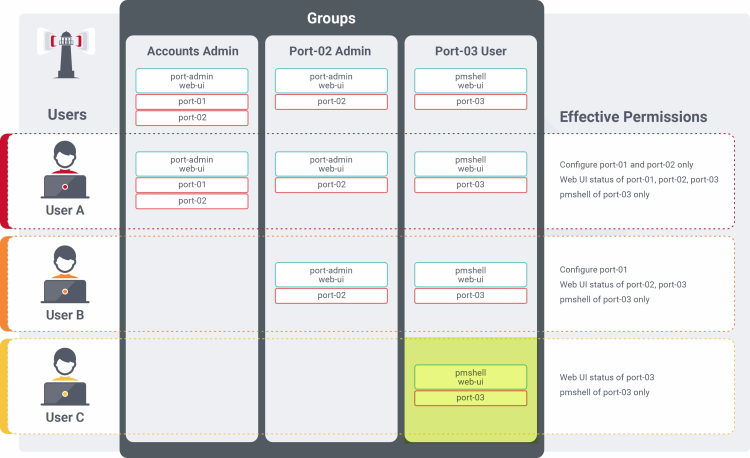Groups
Groups are used to grant privileges to users. When a user is a member of a group, defined privileges may be granted to the group by an Administrator. When editing a group, the (authorized) user selects from a list of devices, all of which are under the heading SERIALLY CONNECTED DEVICES.
Permission Changes in the Web UI
A new feature change called Access Rights was introduced in release 22.11 to replace the previous concept of a user Role and instead uses a set of configurable Access Rights for each group. Each access right governs access to a particular feature (or set of highly related features), with a user only having access to features for which they have an assigned access right.
Tip: To support the new permissions model several rest API endpoints have been updated for the new functionality. Wherever possible, these changes are backwards compatible. See the release notes for details.
Understand Access Rights
An access right is a permit authorizing access to a feature or collection of related features. Holders of the permit (i.e., the access right) are given access to the feature.
A user gains access rights by the following:
-
Access Rights are assigned to Groups.
-
Users are members of zero or more Groups.
-
A User inherits all Access Rights from all the Groups they are a member of.
Some features may require the user to hold multiple access rights to access the feature through a specific interface. For example, a user requires the “right to use the web UI” and the “right to configure serial ports” to make configuration changes to a serial port through the web UI.
Defined Access Rights
There are four defined rights (admin, web_ui, pmshell, and port_config) as summarized in the following table.
| Access Rights | Description |
|---|---|
| admin | The admin access right grants a holder access to everything; every feature and every user interface. |
| web_ui |
Permits access for an authenticated user to basic status information via the web interface and rest API. Users can:
|
| pmshell Restricted CLI | Permits access to devices connected to serial ports. Does not give permission to configure all serial ports, only to those that are added to the same group containing the pmshell rights. |
| Port Config | Permits access to configure serial ports. This access right gives the holder the ability to configure serial ports. This right does not give the holder the ability to access the serial port. |
Tip: A right may be combined with another right for a feature to be accessible by a user. For example, web_ui to log in and port_config to configure a serial port. The port_config right by itself is not useful.
Admin Access Rights (admin)
Any user who was previously an Administrator role now inherits the admin access right, giving that user the same “can do everything” permission.
Tip: The Admin Access toggle switch in the Web UI hides other rights selections as Admin Access overrides all other rights.
WebUI Access Rights (web_ui)
Any user who was previously a Console User role now inherits the web_ui and pmshell access rights and there are no functional changes for this user.
Tip: From release 22.11 in the Web UI, the Rights checkbox replaces the Roles drop-down selection.
The web_ui access right grants the user the ability to
-
log into the WebUI.
-
see a listing of serial ports (The “Access → Serial Ports” menu item).
-
edit a restricted set of user configuration such as changing their own password.
Portmanager Shell Access Rights (pmshell)
Any user who was previously a Console User role now inherits the pmshell access rights and there are no functional changes for this user.
The pmshell access right grants the user access to the serial port web terminals and the ability to use pmshell over SSH. These rights are applied only to the access ports to which they have been granted rights.
Port Configuration Access Rights
The port_config access right grants the holder of this right the ability to make configuration changes to the serial ports they have been assigned. Note that a user without the web_ui right cannot log in to the WebUI to configure serial ports, so a user must inherit the web_ui from at least one group.
Access > Serial Ports View
Users with the port_config access right to some serial ports are able to see the Edit link on the Access > Serial Ports page for those ports only. Non-Admin users with the port_config role are able to see any active sessions on a port but are not able to terminate the session.

Configure > Serial Ports View
The Configure Serial Ports page is accessible to users with the port_config and web_ui access rights appear in the navigation sidebar menu. This page lists ports that the user has both port_config and web_ui access rights.
Tip: It is possible to edit all details on these ports, however, changing the “mode” of a port disconnects any sessions.
Non-Admin Users
Non-admin users with port_config access right are able to perform Serial Port Autodiscovery on the ports that they are able to configure. If autodiscovery is already running, they can see the banner but cannot view the autodiscovery logs or cancel the running job. Non-admin users are not able to configure the Serial Port Autodiscovery Schedule and the icon is hidden, but are able to see which ports are configured of the ports to which they have access.
Protected Groups and Users
Certain types of groups and users have protected status, meaning that they cannot be changed or deleted. Protected groups comprise the following:
-
root- The root user is hard-coded member of the Admin group. As such, the root user cannot be deleted.
-
admin- The Admin group cannot be disabled or changed to a non-admin group.
-
netgrp- The special ‘netgrp’ also cannot be deleted. This group is assigned to users from AAA auth that don’t have a group assigned from the authentication server.
Tip: For these protected groups no 'Delete' button displays beside them in the Web UI.
Understand Serial Port Access
Serial ports are assigned to a group in the same way as access rights are assigned to a group, however, it is the access rights that are assigned to the same group that determine what a user can actually do with those serial ports. The access rights assigned to one group will only apply to the serial ports assigned to that same group, they do not apply to the serial ports of another group.
For example, a user in a group with port_config and port-01 can configure that port but not access the device (as that requires pmshell access rights).
Consider the following two groups, Accounts Admin and Port #03 User:
| Group Name | Accounts Admin | Port #03 User |
|---|---|---|
| Access Rights | port_config
web_ui
|
pmshell
web_ui
|
| Serial Ports | port-01
port-02
|
port-03
|
The effective rights for a user in one or both of those groups is shown in the following table. It shows how access rights assigned to one group will only apply to the serial ports assigned to that same group:
The following table shows the effective rights for a user in one or both of those groups, Accounts Admin and Port #03 User:
| Action | Group Membership | ||
|---|---|---|---|
| Accounts Admin | Port #03 User | Accounts Admin & Port #03 User | |
Configure port-01 |

|

|

|
Configure port-02 |

|

|

|
Configure port-03 |

|

|

|
Access port-01 |

|

|

|
Access port-02 |

|

|

|
Access port-03 |

|

|

|
Note: Note the highlighted cell; a user with pmshell access to port-03 (from the Port #03 user group) does not also get port_config for that port, even though that access right is inherited from the Accounts Admin group. The access rights of a group only apply to the serial ports in that same group. This principle is illustrated in the following figure:
The following image shows how access rights assigned to one group only apply to the serial ports assigned to that same group.
